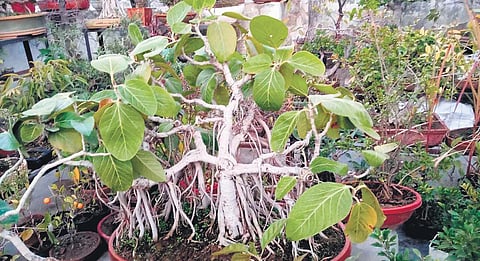

The cramped neighbourhood of West Delhi’s Rohini, which houses tall buildings and tiny balconies, includes a terrace that hosts hundreds of small bonsai trees, adding greenery to the cityscape.
A handiwork of 79-year-old Mangat Singh Thakur, this bonsai garden comprises more than 550 bonsais—it includes species like China orange, mango, guava—that Thakur has diligently tended since 2001. His compact terrace is where he experiments with the art.
Thakur believes that bonsai cultivation is not just a routine practice; it is an art, a philosophy, and a form of exercise. His interest and zest to keep working despite his advancing years keep him going.
Years of learning
A traditional Japanese art form, bonsai cultivation refers to the practice of growing a plant in a miniature form. A bonsai tree, if planted and properly tended, can live for hundreds of years.
Thakur first learnt about the concept in 1978 in a workshop by Indian Bonsai Association at Delhi’s ITC Maurya. Here, Thakur understood the basics of these plants. “The more I got to know about it, the more interested I became,” he recounts. After his retirement in 2001, Thakur decided to further carve out a space for himself to take up bonsai plantation seriously.
The first bonsai he planted was a Banyan tree in 1972, which is still in good shape on his terrace. “This tree has been with me through all my transfers to various places in India. It has taught me a lot about this art,” he comments.
As his collection expands with every passing day, Thakur makes it a point to spend two to three hours in his garden. During the re-potting season (usually in February), he works on his plants for about six hours.
Catalyst for change
Thakur has been able to take the theory and practice of bonsai cultivation to a large audience. He regularly posts informative videos of bonsai on his YouTube channel ‘Bonsai Factory’—he has over 9,000 subscribers—and also conducts virtual classes for enthusiasts. He has taught over 100 students in nine batches; his tenth batch starts in February.
Thakur’s work has also received widespread appreciation. “I have become more popular after retirement than I was when I worked in the bank (laughs).”
Hoping to take these lessons forward, Thakur is in the process of writing a book about bonsai plantations in Hindi. The understanding of bonsai can help farmers utilise their resources properly, and so, Thakur adds, his book will be focused on farmers and gardeners.
“Most books on bonsai are in English and are expensive. I thought I should write in Hindi so that it reaches the common man. I also plan on keeping the cost low so that people can easily buy these books,” he says.
Even though he is nothing short of a master of bonsai cultivation who is well versed in the ins and outs of the art form, Thakur continues to call himself a student. “I am not an artist. I am simply a student and I will stay one till the day I die,” he concludes.